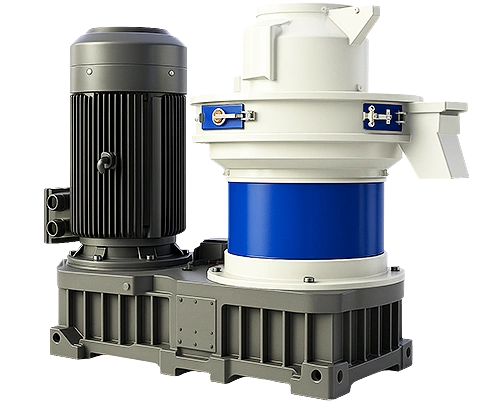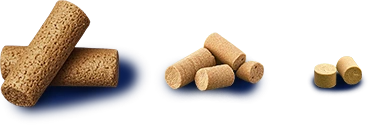Low output, frequent breakdowns, and poor pellet quality are common challenges for pelletizing plants. As demand grows, businesses need higher-capacity, more stable machines. Our biomass pellet machines are built for medium to large production, handling various raw materials to boost efficiency, cut costs, and turn waste into value.

Flat Die vs. Ring Die: Which Is Right for You?
Flat die pellet machines are compact, easy to move, and ideal for small-scale or home use - simple and practical.
Ring die pellet machines, on the other hand, offer higher output, better pellet quality, and greater efficiency. While they require more upfront investment, they deliver superior performance and cost-effectiveness for industrial production.
Both flat die and ring die large pellet mills produce high-quality pellets, but they serve different needs. Your choice depends on your production needs and scale.
(Learn more:Flat Die vs Ring Die Pellet Mill: Which One Is Right for You? )

Product Introduction
A ring die pellet machine is an industrial machine that presses powder or fiber materials into pellets. This makes the materials easier to store, move, and use, while also improving efficiency, cutting waste, and adding value. That's why ring die pellet machines are widely used in many industrial production lines.
Working Principle

The ring die pellet making machine uses a motor-driven roller to press raw materials evenly into a ring-shaped die, where they're compacted and formed under high pressure. The cutter then slices the pellets to uniform length. The process is fully automatic and highly efficient, making it ideal for medium-to-large production.
Machine Structure Highlights

Feeding Motor - Precise control, smooth and even feeding without jams
Main Motor - Powerful drive, efficient, stable, and energy-saving
Feeding Port- Large opening for fast feeding without clogging
Pelletizing Chamber - Wear-resistant alloy rollers for fast, dense pellet formation
Discharge Port - Smooth flow, no buildup, with intact finished pellets
Dust Shield - Sealed and dustproof, long-lasting lubrication
Gear Reducer - Shock-absorbing, low-noise, stable power transmission
Core Advantages
- Durable: High-strength ring die and rollers with excellent wear resistance and long service life.
- High Pellet Quality: Dense, uniform pellets with >98% forming rate and high energy value.
- Handles Many Materials: Works with all common biomass types, even with varying moisture.
- Stable and Easy to Maintain: Fewer breakdowns, long-lasting parts, simple daily care.
- Flexible Output: 0.7–4.5 tons per hour, for both small and large production needs.
- Quick Payback: High output, low costs, fast return on investment.
- Multi-Use: Easily switch dies for making biomass fuel pellets or animal feed pellets.

Wide Raw Material Compatibility

The ring die machine for pellets can process a wide range of materials include:
Agricultural waste: corn stalks, wheat straw, rice straw, rice husks, peanut shells, cotton stalks, soybean stalks
Forestry by-products: sawdust, wood shavings, bark, branch powder, wood powder
Nutshells: coconut shells, apricot shells, walnut shells, palm shells
Other renewable resources: bamboo shavings, bagasse, tobacco stems, herbal residue, biomass charcoal powder
Application Scenarios

Easy to Operate | Full Pelletizing Process
- Crush sawdust, straw, etc., and keep moisture at 12%–18%.
- Before starting, check the die, rollers, motor, and lubrication system.
- Start the main motor and feeding motor in order; once stable, begin feeding.
- Feed slowly and steadily to ensure smooth pressing and avoid blockages or idling.
- Finished pellets will discharge automatically; connect a cooler if needed.
- Stop feeding, let pellets clear out, then shut down and clean; regularly maintain the die and rollers.
Tip: If you don't have a moisture meter, grab a handful of material and squeeze. If it clumps slightly but breaks apart easily, the moisture is likely around 12%–18%.
While a single pellet machine works alone, adding it to a full production line boosts efficiency, improves quality, and supports large-scale output. Ready to increase capacity and reduce labor? Let's build the right biomass pellet line for you - contact us today!
Equipment Specifications
To help you better understand the machine options and configurations, here are the detailed technical specifications of the ring die pellet machine:
| Model | Power (kw) | Capacity(t/h) | Weight (t) | Die Diameter (mm) |
| KH-450 | 75 | 0.7-1 | 4 | 450 |
| KH-560 | 90 / 110 | 1-1.5 | 6.5 | 560 |
| KH-680 | 160 | 1.5-2.5 | 8.5 | 680 |
| KH-850 | 220 | 2-3.5 | 12.6 | 850 |
| KH-880 | 315 | 3.5-4.5 | 14.5 | 880 |
If you're unsure which model to choose, no worries! Feel free to contact us - we'll recommend the best solution based on your raw materials, capacity needs, and application.
Kawise - Your Trusted Pellet Equipment Expert

With years of industry experience, Kawise delivers reliable, efficient pellet solutions tailored to your materials, output, and budget. By choosing us, you can get:
- Stable, high-efficiency machines for various materials
- Full model range, from small runs to large production
- Professional support, no worries during operation
- Custom solutions matched your needs
We don't just offer machines - we offer long-term peace of mind.
Have questions about model selection or system setup? Contact us anytime for expert advice and full support!





